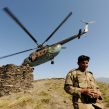
New Strategies in Pakistan’s Counter-Insurgency Operation in South Waziristan
Publication: Terrorism Monitor Volume: 7 Issue: 37
By:

Pakistan’s recent “Rah-e-Nijat” (Path to Salvation) military operation in the South Waziristan agency of the Federally Administered Tribal Areas (FATA) has achieved tremendous success since it began on October 17. It is believed that security forces should be able to clear the main towns of Taliban presence by early December 2009, when it starts snowing in the region (Daily Times [Lahore], November 1). The military operation is patterned on the lines of a similar operation conducted in the Swat district of the North West Frontier Province (NWFP) in April-May 2009, code named “Rah-e-Rast”.
The current military operations have highlighted some new elements in Pakistan’s counter-insurgency warfare which were not seen in previous operations that the Pakistani government conducted during 2003-2008.
1. Pakistan’s counter-insurgency strategy is a comprehensive one that employs a pre and post operation plan aimed at “clear, control and build” in the area cleansed of the Taliban presence. Both the South Waziristan and Swat operations were divided into three phases: 1) seize control of communication infrastructure and clear the adjoining settlements and village, as well as destroy the command and control structure of the Taliban militants; 2) mop-up operations aimed at the remaining terrorist infrastructure in the far-flung areas; and 3) reconstruction of the area and rehabilitation of the internally displaced persons (IDPs).
2. The recent successes in Pakistan’s military operation in Swat and South Waziristan testify to the fact that Pakistan has sufficient counter-insurgency capability to dislodge the Taliban from their strongholds in FATA and NWFP. This nullifies the previous assumptions regarding the Pakistani armed forces that they were tailored to fight conventional warfare against regular armies in plains and deserts and lacked the training and ability to conduct CI operations in mountainous terrain against non-state actors. [1]
3. What also seems new is the Pakistan Army’s willingness to capture and hold all the main population centers in South Waziristan. This important new strategy was first used in Pakistan during the Swat offensive in April 2009. Whether the Pakistan Army will remain deployed in the population centers of South Waziristan remains to be seen. However, Pakistan’s Interior Minister, Rahman Malik, recently hinted at sending additional troops to South Waziristan (The Nation [Islamabad], November 22).
4. Similarly, there is a greater reliance on airpower in both military operations which intends to destroy the defenses of the Taliban militants before the military goes in. What is also new is a much more extensive use of precision-guided munitions by the Pakistani Air Force.
5. The South Waziristan operation was the first major operation where the Pakistani military received intelligence support from the United States, which provided unmanned aerial vehicle (UAV) coverage “on-demand.” This seems to have increased Pakistani situational-awareness in a mountainous rugged terrain where the enemy has the historic advantage of applying ambush and hit-and-run attacks against the Pakistan Army. However, large problems remain in terms of using real time intelligence from the U.S. collection platforms with front-line Pakistani military units. Apart from intelligence sharing, the United States rushed weapons and ammunition worth millions of dollars to Pakistan on an emergency basis to ensure a sustained supply of material to the Pakistani troops battling the Taliban in South Waziristan.
6. The Pakistani Army seems to have done a much better job in conducting intelligence operations. While South Waziristan still remains a “black hole” for the government in terms of human intelligence infrastructure, the ISI seems to have achieved a certain level of penetration of the Tehrik-e-Taliban Pakistan (TTP), including interception of messages carried over one of the TTP’s main communication tools, “Push-to-Talk,” a cell phone option that permits the phone to be used as a walkie-talkie (Kuwait Times, October 19; China Daily, October 22).
7. The public support which the Pakistan Army received from people in the conflict zone as well as from the entire country helped in carrying out the counter-insurgency operations successfully. The popularity of the Taliban – which remained quite high during 2003-2007 – dipped to an all time low. The successful conclusion of the first phase of the counter-insurgency would restore public confidence over the Pakistani armed forces and raise the morale of the security personnel.
However, the current operation in South Waziristan is just one episode of a drawn out battle between the government and the Taliban. Pakistan’s Interior Ministry has already alluded to more operations in Orakzai and Khyber Agencies against the Taliban (The News [Islamabad], November 23). Operations in Kurram and North Waziristan Agencies may not be ruled out in the future.
While it seems that the objectives of the first and second phase of the current military operation could be achieved with less difficulty, it is the third phase – the rehabilitation of the IDPs and rebuilding and reconstructing the entire region – which is fraught with challenges. Pakistan is passing through its worst economic crunch and is unable to undertake massive development to change the economic contours of the region and woo the local population away from the Taliban. A case in point is the Swati IDPs, the majority of whom returned back to areas cleared of the Taliban presence, but where reconstruction work has not yet started.
The recent military successes by Pakistan against the Taliban in FATA and the NWFP provide a ray of hope to both Pakistan and Afghanistan that overcoming the Taliban on both sides of the border may not be impossible, provided the two nations have the will and determination to take on the Taliban. However, any degree of success against the Taliban will remain limited until the root causes of violence in FATA/NWFP, such as poverty, illiteracy and underdevelopment, are addressed.
Notes:
1. Muhammad Khurshid Khan, “Analyzing Domestic Terrorism as a Threat to Pakistan’s Security and the Policy Response,” IPRI Journal 9(2), Summer 2009, pp. 49-76.





